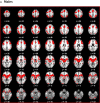A Neural Basis for the Acquired Capability for Suicide
- PMID: 27531983
- PMCID: PMC4970564
- DOI: 10.3389/fpsyt.2016.00125
A Neural Basis for the Acquired Capability for Suicide
Abstract
The high rate of fatal suicidal behavior (SB) in men is an urgent issue as highlighted in the public eye via news sources and media outlets. In this study, we have attempted to address this issue and understand the neural substrates underlying the gender differences in the rate of fatal SB. The Interpersonal-Psychological Theory of Suicide has proposed an explanation for the seemingly paradoxical relationship between gender and SB, i.e., greater non-fatal suicide attempts by women but higher number of deaths by suicide in men. This theory states that possessing suicidal desire (due to conditions such as depression) alone is not sufficient for a lethal suicide attempt. It is imperative for an individual to have the acquired capability for suicide (ACS) along with suicidal desire in order to die by suicide. Therefore, higher levels of ACS in men may explain why men are more likely to die by suicide than women, despite being less likely to experience suicidal ideation or depression. In this study, we used activation likelihood estimation meta-analysis to investigate a potential ACS network that involves neural substrates underlying emotional stoicism, sensation-seeking, pain tolerance, and fearlessness of death, along with a potential depression network that involves neural substrates that underlie clinical depression. Brain regions commonly found in ACS and depression networks for males and females were further used as seeds to obtain regions functionally and structurally connected to them. We found that the male-specific networks were more widespread and diverse than the female-specific ones. Also, while the former involved motor regions, such as the premotor cortex and cerebellum, the latter was dominated by limbic regions. This may support the fact that suicidal desire generally leads to fatal/decisive action in males, while, in females, it manifests as depression, ideation, and generally non-fatal actions. The proposed model is a first attempt to characterize the neural networks underlying gender differences in SB. Future studies should examine the proposed network to better characterize and refine this network using tasks specifically targeted toward constructs underlying ACS.
Keywords: depression; diffusion tensor imaging; functional magnetic resonance imaging; gender difference; meta-analysis; meta-analytic functional connectivity; structural connectivity; suicide.
Figures









Comment in
-
Commentary: A Neural Basis for the Acquired Capacity for Suicide.Front Psychiatry. 2017 May 24;8:93. doi: 10.3389/fpsyt.2017.00093. eCollection 2017. Front Psychiatry. 2017. PMID: 28596741 Free PMC article. No abstract available.
Similar articles
-
The role of emotion dysregulation: A longitudinal investigation of the interpersonal theory of suicide.Psychiatry Res. 2018 Feb;260:379-383. doi: 10.1016/j.psychres.2017.11.075. Epub 2017 Dec 6. Psychiatry Res. 2018. PMID: 29247924
-
Number and violence of suicide attempt methods: A preliminary investigation of the associations with fearlessness of suicide and fearlessness about death.Psychiatry Res. 2018 Jul;265:183-189. doi: 10.1016/j.psychres.2018.04.050. Epub 2018 Apr 26. Psychiatry Res. 2018. PMID: 29727762
-
Stoicism and Sensation Seeking: Male Vulnerabilities for the Acquired Capability for Suicide.J Res Pers. 2012 Aug 1;46(4):384-392. doi: 10.1016/j.jrp.2012.03.004. Epub 2012 Mar 23. J Res Pers. 2012. PMID: 22736874 Free PMC article.
-
["Suicidal intentions": literature review and perspectives].Encephale. 2012 Apr;38(2):118-25. doi: 10.1016/j.encep.2011.06.002. Epub 2011 Aug 11. Encephale. 2012. PMID: 22516269 Review. French.
-
[Social pain at the core of suicidal behavior].Encephale. 2019 Jan;45 Suppl 1:S7-S12. doi: 10.1016/j.encep.2018.09.005. Epub 2018 Nov 11. Encephale. 2019. PMID: 30428996 Review. French.
Cited by
-
Risk-Taking Behavior among Suicide Attempters.J Clin Med. 2022 Jul 19;11(14):4177. doi: 10.3390/jcm11144177. J Clin Med. 2022. PMID: 35887941 Free PMC article.
-
Atypical Cortical Activation During Risky Decision Making in Disruptive Behavior Disordered Youths With Histories of Suicidal Ideation.Biol Psychiatry Cogn Neurosci Neuroimaging. 2020 May;5(5):510-519. doi: 10.1016/j.bpsc.2019.10.016. Epub 2019 Nov 11. Biol Psychiatry Cogn Neurosci Neuroimaging. 2020. PMID: 32007432 Free PMC article.
-
Psychological Pain, Depression, and Suicide: Recent Evidences and Future Directions.Curr Psychiatry Rep. 2018 Apr 5;20(5):33. doi: 10.1007/s11920-018-0893-z. Curr Psychiatry Rep. 2018. PMID: 29623441 Review.
-
Imaging suicidal thoughts and behaviors: a comprehensive review of 2 decades of neuroimaging studies.Mol Psychiatry. 2020 Feb;25(2):408-427. doi: 10.1038/s41380-019-0587-x. Epub 2019 Dec 2. Mol Psychiatry. 2020. PMID: 31787757 Free PMC article. Review.
-
Critical Issues in Men's Mental Health.Can J Psychiatry. 2018 Sep;63(9):590-596. doi: 10.1177/0706743718766052. Epub 2018 Apr 19. Can J Psychiatry. 2018. PMID: 29673272 Free PMC article. Review.
References
-
- Drapeau CW, McINtosh JL. U.S.A. Suicide 2012: Official Final Data. Washington, DC: American Association of Suicidology; (2014). Available from: www.suicidology.org
-
- World Health Organization. Suicide Rates per 100,000 by Country, Year, and Sex. (2011). Available from: www.who.int/mental_health/prevention/suicide_rates/en/index.html
LinkOut - more resources
Full Text Sources
Other Literature Sources

